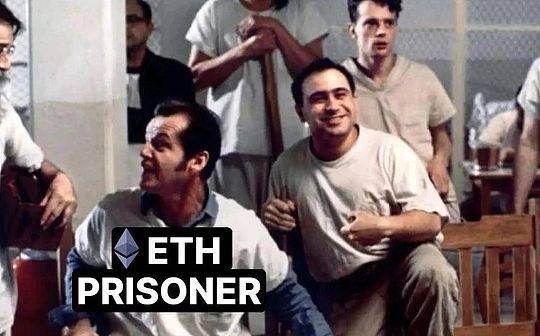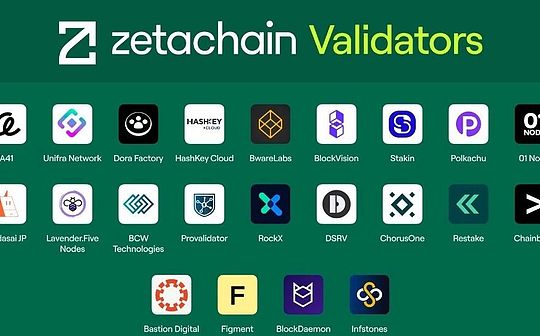
Author: Howe & amp; faust, Geek web3
Foreword:
-
ZetAChain is a POS chain based on the COSMOS SDK, which records cross -chain messages and data initiated on the “external chain” in its block.Users can publish specific formats through the principles of the Ordinals protocol on the “external chain” such as BTC, and convey their “intent” to the ZetAChain network;
-
The node of Zetachain determines which messages to be processed and sequentially through consensus methods. Finally, through the TSS limited signature technology, digital signatures are generated on the target chain, and assets are released from the chain’s public account to trigger subsequent transaction steps.
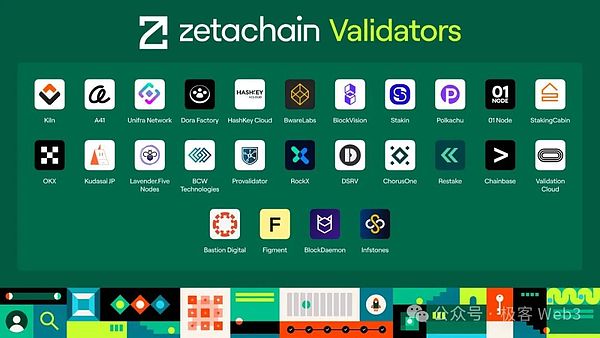
(At present, there are many project parties or institutions, including OKX, Hashkey Cloud, Dora Factory, etc.)
-
Because Zetachain itself is compatible with EVM and supports deployment of contract logic.The full -chain DAPP project party can write the processing procedure of cross -chain messages directly on the ZetAChain chain. There is no need to deploy a bridge to connect to the asset contract on the multi -chain, which can save development costs. From the perspective of the user, theoretically only needs to be on the ZetAChain on the user.Contract interaction instead of multiple interactions with the bridge contract between the source chain-target chain, it can also save the cost of handling fees;
-
Similar to some Intent projects with the effect of “one -stop asset custody chain”, ZetAChain itself supports deployment of asset contracts or DEFI protocols. Users can generate specific messages on the front end of DAPP on different chains.Make asynchronous calls (support the BTC chain account);
-
This seems to make Zetachain directly custody the unified asset account of the full -chain, but to achieve this effect, the exclusive DAPP front is required to cooperate.
-
At present, the most important feature of Zetachain is the underlying facility of across chain and full -chain interoperability. It can not only analyze and process specific cross -chain messages.It is a typical B TO B TO C.
With the continuous development of the blockchain industry, we are in an era of multi -chain interconnection.In this era, different characteristics of public chain have derived differentiated application scenarios, creating a diverse experience for users, but at the same time,The “chain island island” also seems to be more serious.Accounts on different chains are often unable to communicate, and people’s full -chain assets are in a state of splitting but not uniform, which increases the threshold for usage and greatly reduces the user experience.
It can be said that the problem of splitting and inconsistency between heterogeneous chains is one of the main reasons that hinder the growth of user conversion rates.The popularity of the BTC ecology today has further reflected the problem of the heterogeneous operation.
Just as Vitalik Buterin said many years ago:“Multiplica is the future”EssenceAlthough the multi -chain and the existence has become the general trend, it is inThe establishment of a cross -chain bridge between the heterogeneous chain is still a trouble.

In order to solve the problem of multi -chain interoperability, Layerzero, PolyHedra, Map Protocol, Bool Network, and even COSMOS and Polkadot have proposed different chain message transmission solutions. Recently, the Zetachain of Token is also an important one in the entire chain infrastructure layout.member.
In the following,We will briefly conduct the full -chain solution of ZetAChainExplanation of the technical perspective, explanationHow does ZetAChain use the underlying infrastructure of all -chain interoperability DAPP?Realize cross -chain message analysis and processing.
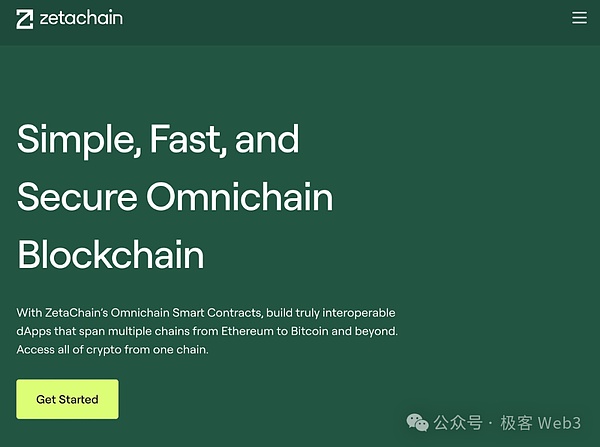
Existing cross -chain solution
In fact, the simplest scene is to solve the problem that the cross -chain bridge is solved. The simplest scene is the transfer of assets on different chains.If you cross -assets from ETH to Polygon, you must first transfer the recharge address specified on the ETH chain to the asset, and then receive equal funds on the Polygon chain.
But the problem is that Polygon’s node cannot confirm what happened on the ETH chain. I don’t know if you really recharge the XX amount.If someone lies, the designated address of the ETH chain is transferred to 100U, and then the withdrawal statement is initiated on the Polygon chain, asking for release of his 100U, which will appear a “withdrawal problem”.
The key to the cross -chain bridge is to solve the “withdrawal of withdrawal of withdrawal” here, that is, confirming that all the withdrawal statements correspond to the real recharge behavior. In essenceNish -related transactions related to cross -chain bridge.
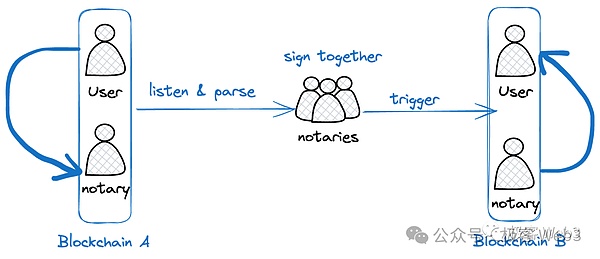
At present, the mainstream cross -chain bridge tends to adopt a notary mechanism, which is to set up a batch of notary nodes to “consensus” through multiple signatures or MPC signatures. As long as most notary people think that your cross -chain behavior can be approved, your assetsYou can go smoothly.
There are also some cross -chain bridges adopting a safer hash lock, or light nodes of other chains with contracts on the chain. By receiving Merkle Proof or ZK Proof, the effectiveness of cross -chain behavior is confirmed, but the cost of this cross -chain bridgeIt is often relatively high, and it will eventually be passed on to the user’s fees.Therefore, most cross -chain bridges still choose the model of notarization nodes under the chain.
Reference materials:Vernacular science: What should I consider when designing cross -chain bridges?Essence
Cross -chain bridges based on notary are often facing huge risks: easy to be attacked by hackers, or admitted to self -theft. According to statistics from Slowmist Hacked, there are 16 cross -chain bridge security incidents in 2022, with losses of 1.21 billion US dollars, accounting for losses on the chain attack incident that year.The total amount of 32%, which shows the harm of cross -chain bridge security vulnerabilities.
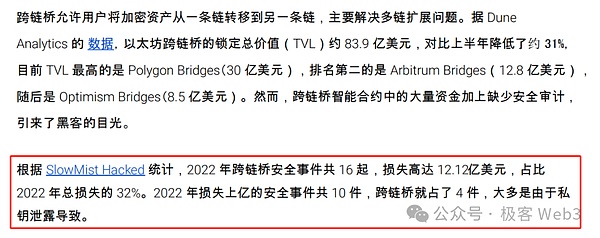
At the same time, most of the existing cross-chain bridge schemes choose the Lock-Mint mode, that is, lock the assets on the A chain, add corresponding mapping assets on the B chain, thereby achieving cross-chain assets.However, in the processing process of this type of scheme, it is necessary to interact with mapping asset contracts multiple times. The handling fee is large, and there is a problem of capital loss.
In addition, many cross -chain bridge solutions only support the asset transfer between EVM compatible chains. Cross -chain behaviors such as Solana and Bitcoin, such as Solana, and Bitcoin, are often subject to different technical standards and are difficult to develop.
Comprehensive safety and handling fees, the current mainstream cross -chain bridge solutions often cannot achieve too good results, and it is not allowed to ensure the “native cross -chain” of assets.In today’s Bitcoin ecosystem, more and more people are eager to achieve a native and seamless cross -chain interactive experience, and look forward to finding a better solution.Zetachain proposed a solution to this.
Function of ZetAChain: All -level infrastructure of all -chain interoperability DAPP
Zetachain’s self -positioning is the infrastructure of the all -chain interoperability DAPP. It specializes in the application protocol of various full -chain interconnection. It is a typical B to B to C underlying infrastructure.Through the POS access mechanism, it allows any nodes of pledged assets to enter the network and serve as notarized people.All POS nodes are signed by TSS thresholds and participated in the verification and processing of cross -chain messages to improve security as much as possible.
At the same time, smart contracts can be deployed on Zetachain, adding business logic related to asset interchange. Users can send messages in a specific format on any chain, call ZetAChain or the multi -chain Defi contract that supports it, and on the BTC chain, justYou can indirectly call the DEFI function on Polygon.The effect achieved in this way is to transmit messages between different blockchains to achieve interoperability.
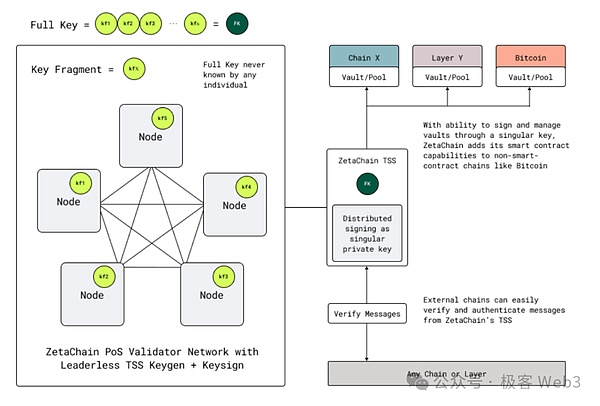
DAPP based on the full -chain interoperability scenario can deploy the business logic of asset exchange on Zetachain to help users automatically exchange GAS tokens on different chains.
For example, you can send a specific format message through the front end of some full -chain DAPP through the data release method similar to the Ordinals protocol on the BTC, indicating that the XX contract on the Solana is called.Essence
After that, the AMM contract on the ZetAChain can automatically calculate the exchange ratio of BTC and SOL, then release the equal SOL on the Solana chain, complete the complex operation of subsequent calls, and then transfer you to your deserved assets back to you to youBTC address or solana address,This is the so -called “full -chain interoperability”. You only need to post a message on a chain to remotely call the DAPP on multiple chains.Of course, this involves the release and trigger process of several asynchronous messages.
Here, we canUnderstand ZetAChain as a “chain settlement layer”, all multi -chain interaction scenes, such asA DAPP that initiates the B chain on the chain A is equivalent to “settlement” with ZetAChain first, and then Zetachain will synchronize the settlement results of the preprocessing to the corresponding account of the B Chain, and then complete the subsequent steps.
There is no excessive interaction with mapping asset contracts in the whole process and friction with the fees of the mapping asset contract.Asset circulation is completed by Zetachain’s public accounts on different chains. This does not need to deploy mapping asset contracts on different chains like traditional cross -chain applications.
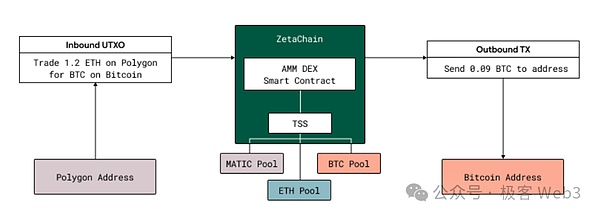
At present, the full-chain application based on Zetachain can save a lot of trouble. At least there is no need to make full effort on different chains to mappore asset contracts., All are “contracted” by Zetachain.In other words, you only need to deploy business logic related to cross -chain transactions on Zetachain.
This is convenient for different full -chain applications to support non -EVM chains such as Solana, Algrand, Bitcoin, and Dogecoin. It does not require exhaustion to implement exclusive contracts for cross -chain applications on different chains.
In addition, Zetachain itself also supports deployment of asset contracts or AA accounts. Users on different chains can send messages in specific formats to call, as if operating a unified account of full -chain. This design idea is on the Particle Chain of Particle Network.It is also reflected that the final effect is:
Users can try to record the data of the assets on a chain of ZetAChain or Particle Chain. When necessary, send call messages through the DAPP front end of the “external chain”, call its asset contract on Zetachain asynchronously, and then ZetAchain will pass throughPublic accounts on the external chain, transfer certain assets to the address specified by the user message, or interact with the DEFI protocol specified by the user.
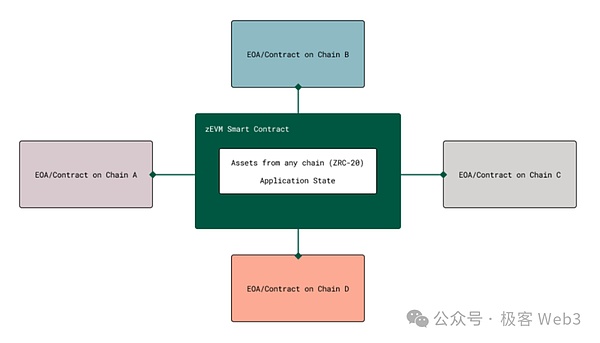
Of course, this series of operations require a special front -end DAPP to implement, that is, Zetachain itself only provides services for all -chain facilities, and it is necessary to have a special front -end entrance to generate special format messages.
Zetachain’s security model: large notary node network based on POS pledge
In the final analysis, Zetachain is essentially a non -notary node network for cross -chain message processing. It is based on COSMOS SDK.Anti -witch and bottom safety.
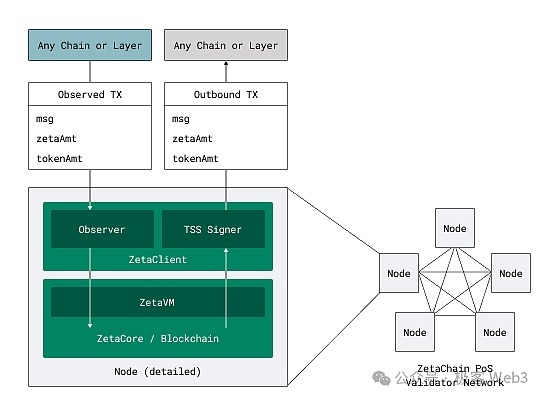
Validator nodes in the ZetAChain network, as decentralized notary,They will confirm which cross -chain requests to be dealt with on other chains will be triggered, and through consensus, they can record these cross -chain behaviors and follow the steps.Through the TSS distributed key signature, Zetachain can generate trading instructions on other chains.
It can be said that what Validator does is similar to the cross -chain bridge in the notary mode, but through POS pledges, notary nodes are more trustworthy to solve the witch problem.

(At present, the list of nodes of Zetachain’s verifications, there are many items or institutions)
The Validator client of ZetAchian contains two modules: Zetacore and ZetAclient.The Zetacore module participates in the generation and consensus process of the Zetachain block. The ZetAClient module observes events on the external chain and signed the station transaction.
HereOut of the station, you can simply understand it to send the transaction log records on Zetachain to the “external chain” (that is, other chains outside ZetAChain), so as to trigger the corresponding behavior on the target chain,The contents of the sending mainly include the contract address, chain ID, and message content that the user declare to call in the message. In fact, it is similar to the log part in the Ethereum transaction.
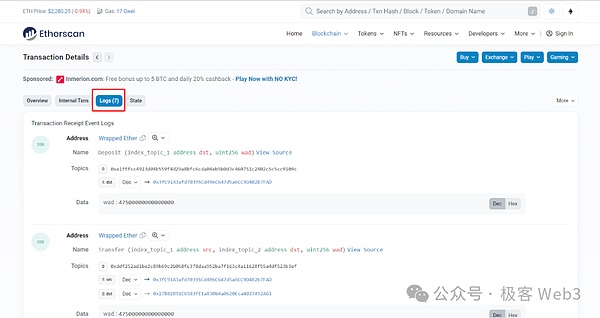
Conversely, the entry can be understood to record related messages/transactions on the external chain outside ZetAChain, such as cross -chain requests, calling smart contracts on Zevm, and other contents to Zetachain.
You need to pay attention here,When the Validator node of the ZetAChain is actually run, the client code contains three modules: verification, observer, and TSS signature.These three modules are responsible for different functions, but they belong to the Zetachain client.

Observer and TSS signature module
First of all, all Zetachain nodes have the module of the “verification”, which is basically the same as the function of the Validator node in the POS public chain. It is necessary to participate in the block and consensus process.In addition, nodes can vote to participate in the chain proposal according to the pledged token ratio.The block of ZetAChain contains all cross -chain records, all -chain smart contract interaction and other behaviors, which are equivalent to logging.
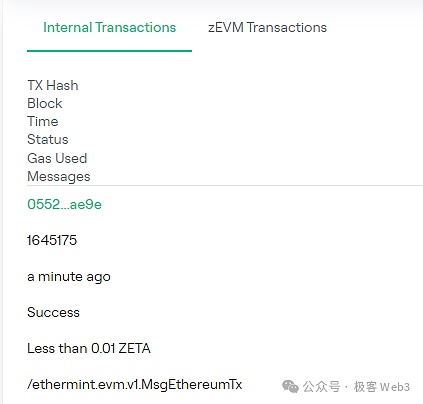
The “Observer” module in the Zetachain client will monitor cross -chain transactions/messages in specific formats by running a full node/light node of other public chains.Observer modules can be divided into two modes: active mode and passive mode.
Different ZetAChain nodes can make a choice and switch the observer module to one of the two modes.Observer modules will continue to be monitored. Whether other chains have Zetachain -related cross -chain messages/events. If so, the observer module of the ZetAChain node will report the situation to the verification module.These observed cross -chain messages will be submitted to the block of Zetachain to confirm through consensus.
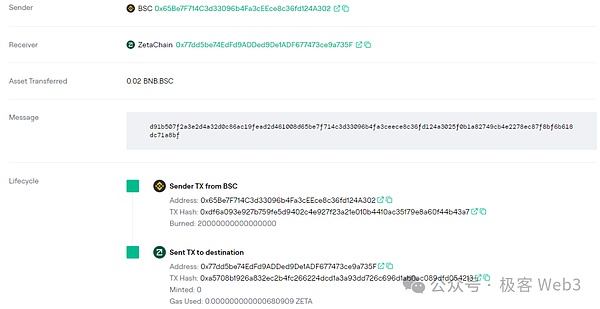
Observer modules have two modes: active mode and passive mode.In the active mode, the node will continuously scan the transaction/event/state on the blockchain outside the zetAChain, and run the FullNode of other chains; and in the passive mode, the complete blocks of other blockchain are different, and the passively uses other ZetAChain nodes.At the same time, receive the analysis of the cross -chain messages.
However, although the nodes in passive mode, although the complete external chain block is not synchronized, the block head will be synchronized, and these cross -chain messages/transaction data are really existing on the external chain through Merkle.
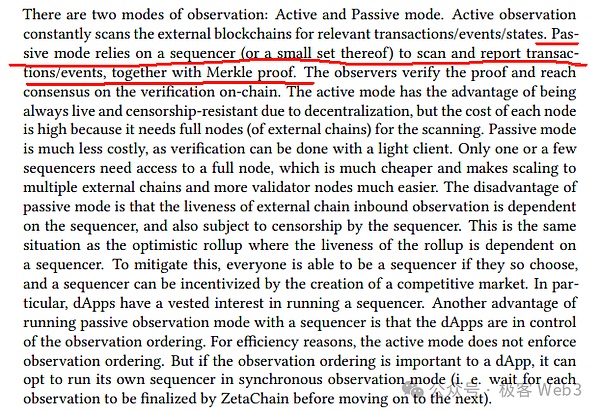
The advantage of the active mode is that most Zetachain nodes will synchronize data on the external chain. At this time, the anti -examination is the strongest. Any user must interact with Zetachain.Essence
However, in the active mode, the cost of running nodes is high. In addition to running the node client of Zetachain itself, it is also necessary to run the entire node of the external chain, simultaneously synchronize data and scan.In the passive mode, the operating cost of ordinary observer nodes is much lower. Only a certain node to run the full node client that runs the external chain. Other nodes only run the light client with the external chain and do not need a complete block of the external chain.
In this way, the cost in passive mode is cheaper, and it is easier to expand the number of nodes, which is convenient for connecting multiple external chains.However, the disadvantage of passive mode is that the data observation activity on the external chain depends on a few nodes and poor anti -examination.
To alleviate this situation, ZetAChain will motivate nodes to run an active mode observer module.
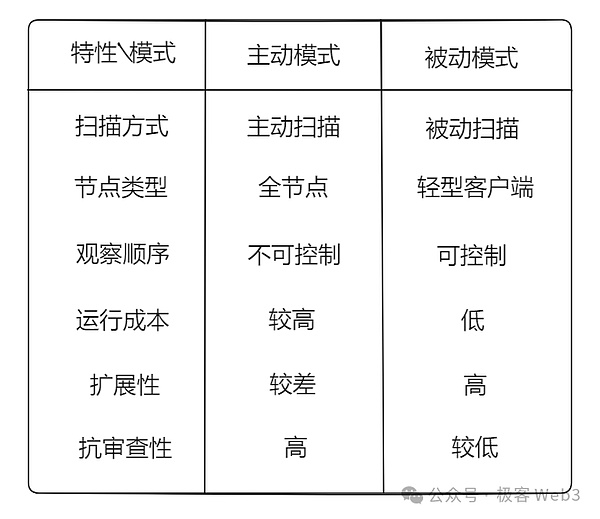
(In the active mode, the node also needs to run the full node client of the external chain; in the passive mode, the light client that only runs the external chain, from the active mode of the Zetachain node, receive the cross -chain message+Merkle Proof to confirm the effectiveness of the message validity of the messagesex)
TSS signature
All cross -chain messages observed and verified by the ZetAChain node will eventually trigger a transaction behavior through the public account address of Zetachain on the target chain, and then perform subsequent operations.In this process, you need to sign a digital signature for the cross -chain transaction on the target chain.
In order to ensure security and trust, the generation of signature is undertaken by all nodes of Zetachain to store key fragments used to generate signatures.These key fragments are distributed between multiple signaturers. Only most signatures have signed the external chain to generate digital signatures of transactions on the external chain.At any time, a single entity or a small number of nodes cannot represent Zetachain trigger transactions/sign messages on the external chain
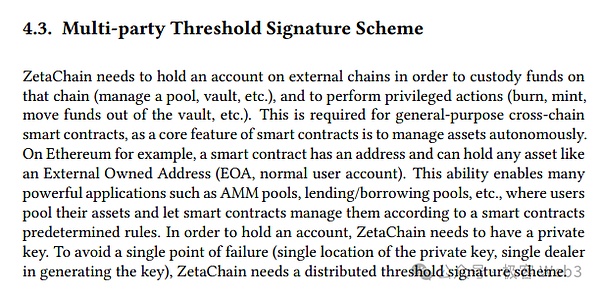
(In Zetachain’s cross -chain model, you only need to have a public account address on different chains without deploying complex smart contracts)
The multi -signing algorithm of ZetAChain adopts TSS, which is called Threshold Signature Scheme Signature Signature Scheme.For the outside world, the trading number signature we can see, although only corresponds to a private key, public key, and address, in fact, this private key is generated by many segments, which is generated without intermediate people. These areThe fragments are located in all ZetAChain nodes.At any time, neither individual entity or minority verifications cannot represent the network as a whole to put together private key fragments and sign messages.
The TSS key generation and signature process, through the method of multi -party calculation (MPC), will not leak any secrets of any participation nodes.The node of ZetAChain can generate transaction signatures on different chains. On the basis of compatible EVM chains, the function of remote calling smart contracts for Bitcoin/non -intelligent contract chain has been added. The intuitive experience is like BTC users can directly call users to call directly to call users.Some DEFI functions.

This scene is actually particularly suitable for multi -chain Defi applications equipped with BTC ecology, because the BTC chain cannot achieve too complicated business logic, and can only rely on external facilities to remotely call certain DEFI contracts.These characteristics of Zetachain are suitable for users in the BTC ecology to call asynchronous calls.
ZEVM: One -stop full -chain DAPP contract platform
Different from the traditional cross -chain solution, the mapping asset contract should be deployed on each chain. Zetachain can only deploy a smart contract on its own chain, that is, the multi -chain cross -chain function.In Zetachain, there is an EVM compatible execution layer called ZEVM, and cross -chain smart contracts can be directly deployed on ZEVM.
ZEVM supports the following functions:
Anyone can send a specific format trading data on the external chain, call a contract on ZEVM;
The contract logic on ZEVM can control the exit transaction data generated on the external chain.
These two additional functions make ZEVM support universal programming, which can deploy specific business logic, and modify the status of different chains at an atomic manner.If a cross -chain operation occurs, Zetachain detects the follow -up steps of this cross -chain behavior, and it is not successful in the target chain, you can roll off the data modified in the cross -chain transaction in the ZetAChain contract, as if everything is everythingNo.
At the same time, the full -chain application DAPP does not need to deploy mapping asset contracts on different chains. You only need to concentrate the logic of the message cross -chain through the contract on the ZetAChain chain.Go to the multi -chain network.
This can greatly save the cost of full -chain DAPP development.At the user level, because you do not need to frequently interact with the mapping asset contracts on the multi -chain, the cost is lower than the mainstream cross -chain bridge that needs to deploy mapping asset contracts on different chains.
In addition, special DEFI contracts and ZRC-20 and even NFT assets can also be deployed on Zetachain to synchronize the asset status or deploy AA accounts.This has a unified asset management (status record) platform function.Because we no longer need to work hard to have assets on multi -chain, this full -chain unified asset account scene can give more imagination in the future.
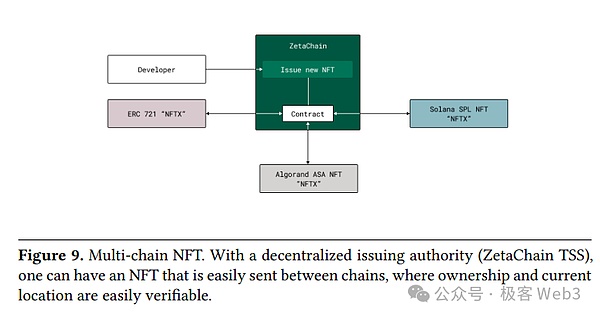
Summarize
Through the previous content, we have more or less understanding the identity of Zetachain’s “full -chain interoperability infrastructure”.It monitors specific messages/transactions of the external chain through the observer module in the Validator client, and reports it to the verified module, and finally consensus the message on the Zetachain network.Then analyze the data contained in the message, use TSS to generate digital signatures, and trigger the subsequent transaction process on the corresponding target chain to achieve the interaction on the full -chain.
At the same time, the full -chain smart contract based on Zetachain allows us to closely interact with different blockchain without using mapping asset contracts on different chains. This can avoid calling redundant contract logic and saving procedures for procedures.Fees cost.
At the same time, because Zetachain itself is compatible with EVM, any DAPP developer or even individual users can deploy customized cross -chain message processing logic. Theoretically, you can deploy a full -chain DAPP contract in one stop.Frequent deployment/update mapping asset contract logic on the chain eliminates the cost of repeating wheels.



